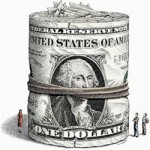CLSA-Pacific’s economics team estimates that this year inflation will rise to 7 per cent in China (compared to 3 per cent last year) and 9 per cent in Indonesia (from 5 per cent). Next year they estimate inflation will hit 10 per cent in the Philippines and 8 per cent in Thailand.
However, in many emerging economies central banks are unwilling to increase interest rates through fear that that will attract even more of the unwelcome foreign hot money that puts upward pressure on their currencies. They are suffering from importing the infection of the US’s low-interest and money-printing policy.
They are also nervous about over-reacting to inflation and so damage the high rates of economic growth to which their societies are wedded. Most experts reckon that tightening will continue in China, for example, but remain cautious and steady. Beijing is more worried about slowdown than about inflation and focuses its tightening on asset-speculative sectors such as property.
In the much larger group of advanced economies there is still so much spare capacity in factories and in labour pools that central banks resist pressure to start raising interest rates, which they know they will have to do eventually because of fast-growing official debt, and because they fear the dangers to economic growth from the shock of higher costs of servicing debt.
The bankers, seeing the excess capacity in their economies, believe that the current inflation pressures are not dangerous because they’re temporary and won’t spread significantly into prices generally. Levels of “core inflation” – the concept that excludes prices of major items such as foodstuffs and oil on the grounds that their rises are largely temporary – remain at very low levels in the advanced economies.
I agree with the central bankers’ caution, at least this time around. I reckon that the current panic over inflation is a short-term phenomenon. It’s likely to persist for some months, but then fade as food prices fall and industrial commodities lapse into at least medium-term corrections.
The inflation fear could disappear quickly if there is some major deflation shock such as a generally-unexpected slowdown in major economies such as the US or Europe. As George Gonsalves of Nomura Securities International says: “There are still a lot of risks out there that are unresolved.”
There are already several indications that the inflation fear is excessive. One scarcely-mentioned sign is that risk-aversion, which reflects fear of deflation rather than inflation, remains strong, as can be seen from the continuing strength of the currencies that are the biggest beneficiaries of that aversion, the yen and the Swiss franc.
Besides, it can be argued that recently much of the increase in the prices of industrial commodities has been driven by speculation, and that could quickly go into reverse if there is a change in general business optimism about economic growth. Or speculation is restricted by political action.
There are already early signs that prices could be topping out. One of the most obvious is the way oil – which incidentally accounts for about half the total weighting in all-commodity indexes – has struggled to reach and stay around $100 a barrel.
For the moment, it makes sense to be wary of fixed-interest securities and emerging-market equities sensitive to interest-rate increases. But Dizard advises: “We are in a slack tide between deflationary and inflationary forces in the world, which means you shouldn’t overpay for inflation protection.”
this article is a continuation of – Inflation: a Menace or a Mirage?
CopyRight – OnTarget February 2011 by Martin Spring




